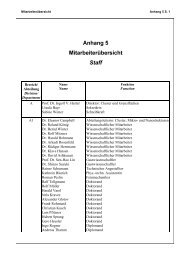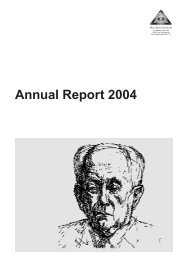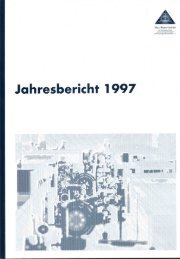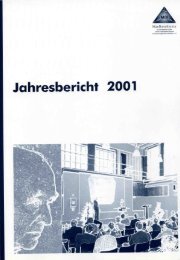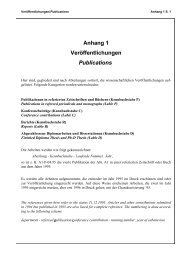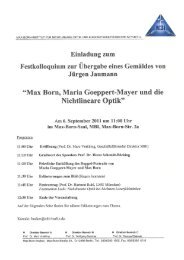Create successful ePaper yourself
Turn your PDF publications into a flip-book with our unique Google optimized e-Paper software.
On the Fiftieth Anniversary of<br />
the Nobel Prize being Awarded<br />
to <strong>Max</strong> <strong>Born</strong> Knut Urban<br />
Forschungszentrum Jülich<br />
<strong>Institut</strong> für Festkörperphysik<br />
Jülich, Germany<br />
Ladies and Gentlemen,<br />
On the occasion of this event commemorating the fiftieth anniversary of the Nobel Prize for<br />
Physics being awarded to <strong>Max</strong> <strong>Born</strong>, I would like to express warmest greetings to you from the<br />
German Physics Society.<br />
We also send kind regards to the Directors of the <strong>Max</strong> <strong>Born</strong> <strong>Institut</strong>e, Professors Sandner, Elsässer<br />
and Hertel, and their staff. With its work in the field of laser physics, nonlinear optics and<br />
short pulse spectroscopy, the <strong>Max</strong> <strong>Born</strong> <strong>Institut</strong>e is an outstanding international institution and<br />
is a great credit to <strong>Max</strong> <strong>Born</strong>’s name.<br />
When we today celebrate the anniversary of <strong>Max</strong> <strong>Born</strong>’s Nobel Prize, we commemorate a scientist<br />
who was, in particular, a model for his own generation and for the generation of his many<br />
distinguished students. His personality still illuminates our work today and even in future he<br />
will continue to be a reference point for young physicists with respect to the link between<br />
research, teaching and social responsibility.<br />
<strong>Max</strong> <strong>Born</strong> had the great good fortune not only to be a witness to events but to be an active<br />
participant in one of the greatest scientific upheavals in the history of mankind. When he was<br />
appointed to the chair of the Second Physics <strong>Institut</strong>e at the University of Göttingen in 1921,<br />
<strong>Born</strong> could already look back on an impressive scientific career. The stages in this career comprise<br />
the development of the quantum formulation of specific heat together with Theodor van<br />
Karman in Göttingen in 1912, at the same time as the work by Peter Debye in Zürich on the<br />
same topic, and the book “Dynamics of Crystal Lattices” in 1915. With this work and his many<br />
years of research in this field, <strong>Born</strong> became the father of crystal lattice theory.<br />
In addition to <strong>Max</strong> Planck, he was associate professor of theoretical physics in <strong>Berlin</strong> and in<br />
1919 was appointed to a chair of theoretical physics in Frankfurt. Otto Stern was then the first<br />
in <strong>Born</strong>’s undoubtedly unique series of outstanding assistants, who on the basis of their work<br />
in the immediate circle around their great teacher became Nobel laureates themselves. At this<br />
time, in 1920, <strong>Born</strong> also published his book “Einstein’s Theory of Relativity”, a popular representation<br />
of both the special and the general theory of relativity, which he developed from the<br />
manuscripts of numerous popular science lectures on this topic for the public at large. A few<br />
weeks ago, I once again looked into this book that I bought as a student almost forty years<br />
ago. It is still very readable even today and, moreover, in addition to the scientific content also<br />
represents a model for the popular treatment of complex facts.<br />
<strong>Max</strong> <strong>Born</strong> • Knut Urban<br />
47



